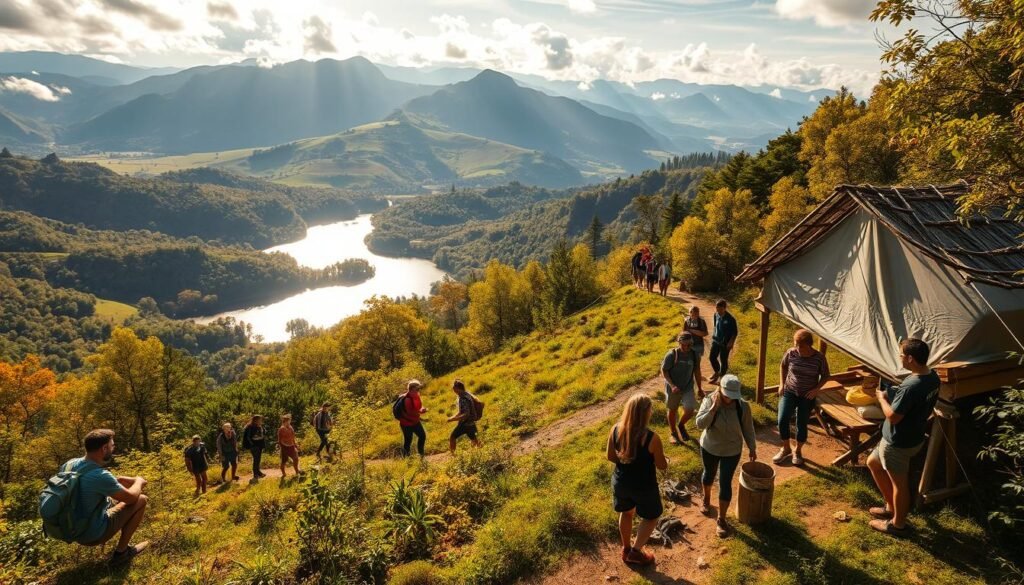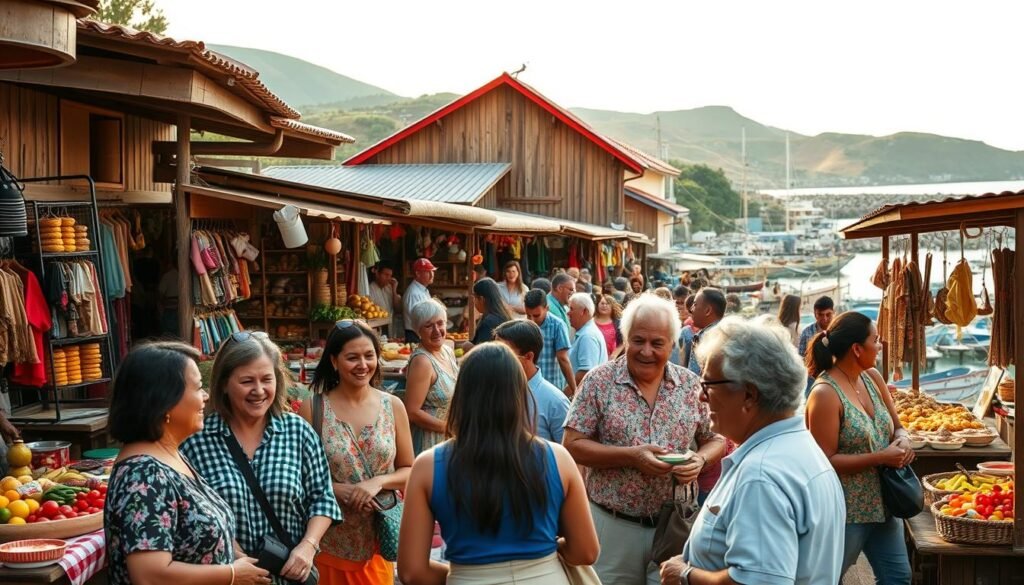Imagine starting a journey that amazes you and helps the planet. Eco-friendly adventures are becoming more popular. We’re excited to share stories of responsible travel.
Our collection of sustainable travel tales shows the beauty of community-based tourism. Each story gives a peek into the positive effects of eco-friendly travel. It highlights the importance of keeping local cultures alive.
These stories remind us that our travel choices matter. By choosing responsible tourism, we help create a better future for all.
Key Takeaways
- Discover the impact of eco-friendly adventures on local communities.
- Learn how sustainable travel practices can preserve cultural heritage.
- Explore the benefits of community-based tourism.
- Find inspiration for your next responsible travel journey.
- Understand the importance of preserving local cultures through travel.
What is Sustainable Travel?
Traveling sustainably means making choices that help the environment and local cultures. It’s about knowing how our trips affect places and trying to make them better.
Understanding the Concept
Sustainable travel, also known as eco-tourism, focuses on protecting nature and respecting local ways of life. It’s about traveling in a way that supports the places we visit and keeps them special for others in the future.
Why It Matters
The tourism world affects the environment a lot, from air pollution to using up local resources. By choosing sustainable travel, we can lessen these problems. It also helps local economies and keeps cultural sites alive for future visitors.
Reducing our carbon footprint is key in sustainable travel. We can do this by using green transport and staying in places that care for the environment.
Key Principles of Sustainable Travel
The main ideas behind sustainable travel are:
- Respecting local cultures and traditions
- Supporting local businesses and communities
- Minimizing waste and reducing carbon footprint
- Conserving natural habitats and wildlife
By following these ideas, travelers can help keep the places they visit beautiful and thriving. This makes tourism better for everyone.
Benefits of Sustainable Travel
Sustainable travel is becoming more popular as people learn about its impact. It helps protect the environment, supports local economies, and lets us experience different cultures.
Environmental Impact
Sustainable travel is good for the planet. By staying in eco-friendly places and reducing waste, we can lower our carbon footprint. For example, using public transport or bikes instead of cars cuts down on pollution.
| Environmental Benefit | Action | Impact |
|---|---|---|
| Reducing Carbon Footprint | Using public transport or cycling | Minimizes air pollution |
| Conserving Water | Taking shorter showers | Preserves local water resources |
| Reducing Waste | Avoiding single-use plastics | Decreases landfill waste |
Cultural Preservation
Sustainable travel helps keep cultures alive. By connecting with local people and respecting their ways, we help protect cultural heritage. Supporting local artists and joining community tours are great ways to share cultures.
It also helps keep historical sites and traditions safe. By visiting these places carefully, we help keep them for the future.
Economic Advantages for Local Communities
Sustainable travel is good for local economies too. By choosing local businesses and services, we help the community. This improves people’s lives and makes the economy stronger.
- Supporting local businesses
- Participating in community-based tourism
- Promoting local artisans
In summary, sustainable travel has many benefits. It helps the environment, culture, and local economies. As travelers, choosing sustainable options is our duty to protect the world for the next generations.
Inspiring Stories from Around the Globe
From Costa Rica’s rainforests to Nepal’s mountains, green vacation tales are changing how we see our planet. These stories show the beauty of our world and the good that comes from traveling sustainably.
Eco-Tourism in Costa Rica
Costa Rica leads in eco-tourism, with its rainforests, wildlife, and beaches. It’s dedicated to conservation, with over a quarter of its land protected.
Visitors can hike, zip-line, and stay in eco-lodges. These activities are fun and help local communities and conservation.
Wildlife Conservation in South Africa
South Africa is famous for its wildlife and conservation work. Its parks and reserves are home to many animals, including the Big Five.
Guests can go on safaris to see these animals up close. Safaris here support conservation and help local communities.
Responsible Trekking in Nepal
Nepal’s Himalayas offer amazing trekking paths. The country is moving towards more responsible trekking, focusing on the environment and local economies.
Trekkers can enjoy beautiful views while staying in sustainable lodges. Trekking in Nepal also helps the local economy by creating jobs and promoting cultural exchange.
These green vacation tales from Costa Rica, South Africa, and Nepal show how travel can change places and people. By choosing eco-friendly options, travelers can help protect our planet and preserve cultures.
Sustainable Travel Practices for Your Journey
Starting an eco-friendly trip needs careful planning. Knowing how to travel green is key. By adding green habits to your travel, you can lessen your impact on the planet.
Packing Essentials for Eco-Conscious Travelers
Packing right is a big part of traveling green. Here are some must-haves:
- Reusable water bottle: Carry a refillable water bottle to cut down on plastic waste.
- Cloth bags: Use reusable bags for shopping and carrying things.
- Eco-friendly toiletries: Pick toiletries without harmful chemicals and in sustainable packaging.
- Lightweight, versatile clothing: Pack clothes that can be mixed and matched to avoid too much luggage.
Choosing Green Accommodations
The place you stay can really affect the environment. Look for places that care about the planet:
- Eco-lodges: Eco-lodges aim to reduce their environmental impact while giving a special experience.
- Hotels with green certifications: Find hotels that have been certified for their green efforts.
- Local, family-run guesthouses: Staying in local guesthouses helps keep money in the community.
As travelers become more aware of their choices, more places are going green. This means more options for eco-friendly stays.
“Sustainable tourism is not just about preserving the environment; it’s also about respecting local cultures and supporting local economies.”
Supporting Local Businesses
Connecting with local businesses helps the local economy and lets you see the real culture of your destination:
- Local restaurants and cafes: Try local food at family-owned places.
- Artisanal shops: Buy unique, handmade items that support local artists.
- Local tour operators: Pick tours run by locals to keep your money in the community.
By choosing these options, travelers can make their trips more sustainable. This helps the places they visit in big ways.
Must-Visit Sustainable Destinations
The rise of sustainable travel has led to a surge in destinations prioritizing environmental stewardship. These places offer unique experiences for the mindful explorer. As travelers become more eco-conscious, destinations worldwide are adapting to meet this demand.
Cities Leading the Charge in Sustainability
Cities around the world are taking significant steps towards sustainability. This makes them ideal for travelers who wish to minimize their environmental footprint. Copenhagen is a prime example, aiming to become carbon neutral by 2025. Visitors can explore the city’s green roofs, bike-friendly streets, and innovative waste management systems.
Another city making waves in sustainable travel is Vancouver. It’s known for its green spaces and eco-friendly policies. The city’s seawall, one of the longest pedestrian and cycling paths in the world, shows its commitment to sustainability.
Tropical Paradises with a Green Focus
Tropical destinations are not just about sun and sand; many are now embracing sustainable tourism. The Maldives, famous for its luxury resorts, is also a leader in sustainable practices. Many resorts there implement renewable energy systems and marine conservation programs.
Costa Rica is another tropical paradise leading in eco-tourism. With its rich biodiversity and commitment to conservation, Costa Rica offers travelers the chance to explore rainforests, beaches, and wildlife while supporting local communities.
Winter Retreats That Prioritize Nature
For those seeking a winter wonderland, several destinations offer sustainable winter retreats. Whistler in Canada is a prime example, having hosted the Winter Olympics in 2010. It continues to be a leader in sustainable mountain tourism, with initiatives aimed at reducing carbon emissions and protecting wildlife habitats.
Switzerland’s ski resorts are also models of sustainability. Many resorts invest in renewable energy and implement eco-friendly practices to minimize their environmental impact.
Volunteer Travel: Give Back While You Explore
Volunteer travel lets you make a difference in the places you see. It’s a mix of adventure and helping others. You can help local communities and protect the environment.

sustainable travel talesOpportunities for Responsible Volunteerism
Responsible volunteerism means really helping where you go. You can work on projects like saving nature or helping communities. The goal is to help in a way that lasts and helps the people there.
The Adventure Travel Conservation Fund (ATCF) supports projects that protect nature and culture. This helps the local economy and keeps cultural and natural spots safe.
“Volunteer tourism can be a powerful tool for conservation and community development when done responsibly.”
Top Organizations to Consider
There are many groups dedicated to good travel and volunteering. Some top ones are:
- World Wildlife Fund (WWF)
- The Nature Conservancy
- International Volunteer HQ
These groups have many projects, like saving animals and teaching. They help you find something that fits your interests and skills.
| Organization | Project Types | Locations |
|---|---|---|
| World Wildlife Fund | Wildlife Conservation, Community Development | Africa, Asia, South America |
| The Nature Conservancy | Ecosystem Restoration, Conservation | North America, South America, Asia |
| International Volunteer HQ | Community Projects, Wildlife Conservation | Africa, Asia, Europe |
Impactful Trips Around the World
Some of the best volunteer trips are in places full of nature and culture. For example, helping animals in South Africa or helping communities in Nepal is very rewarding.
These trips help local areas and teach you about different cultures. You learn about global issues in a real way.
By choosing volunteer travel, you make your trips count. You leave a positive mark on the places you visit.
Sustainable Travel Tips for Families
Traveling sustainably with your family can create lasting memories and teach valuable lessons. When planning your next trip, think about making eco-friendly choices. These choices benefit both your family and the planet.
Eco-Friendly Choices for Families
Choosing sustainable options for family travel can be fun and educational. Here are some tips:
- Choose eco-friendly accommodations that care about the environment.
- Use public transportation or walk/bike when you can.
- Pack lightly and avoid single-use plastics.
- Support local businesses and try local food.
Involve your kids in planning to teach them about sustainable travel. Let them help find destinations and activities that match your family’s values.
Educational Activities for Kids
Traveling is a great chance to teach your kids about cultures and the environment. Look for activities that promote learning and sustainability:
- Visit local environmental centers or national parks.
- Join beach cleanups or conservation projects.
- Take a guided nature tour to learn about local wildlife.
These activities educate and create lasting memories for your family.
Family-Friendly Destinations
Some places are better for family-friendly sustainable travel. Look for destinations focused on eco-tourism and sustainability:
- Costa Rica for its rainforests and eco-lodges.
- Iceland for its commitment to sustainability and natural beauty.
- New Zealand for its stunning landscapes and outdoor activities.
When planning, choose destinations that match your values and offer sustainable travel opportunities.
Have a memorable trip that supports responsible tourism? Share your story with our travel blog. Join a community working to make travel better for everyone and the planet.
The Role of Technology in Sustainable Travel
Technology is changing how we travel sustainably. As we become more eco-friendly, tech helps us explore the world better. It supports mindful explorer experiences.
Apps for eco-conscious travelers are a big part of this change. They help us choose green hotels and routes that cut down on carbon. This makes our travel choices more sustainable.
Apps for Eco-Conscious Travelers
Many apps now help sustainable travelers. For example, some find eco-friendly hotels. Others share tips on sustainable travel. Companies like Natural Habitat Adventures use tech to help the environment.
Innovations in Green Transportation
Green transportation is getting a tech boost. Electric cars, biofuel planes, and better public transit are leading the way. These changes help reduce travel’s carbon footprint.
Social Media’s Influence on Sustainable Choices
Social media is shaping our travel choices. People share their eco-friendly travel stories and tips. This encourages others to travel sustainably and supports green destinations.
As tech keeps improving, it will play a bigger role in environmentally conscious journeys. By using these tools, we can help make travel more sustainable for the future.
Local Communities and Sustainable Tourism
Sustainable travel is about making real connections with local cultures. When we travel, we must see the important role local communities play in our experiences.

Engaging with Native Cultures
Connecting with native cultures is key in sustainable tourism. It’s not just about visiting places; it’s about understanding and respecting local ways of life. Travelers can help keep cultural heritage alive by joining local traditions, going on community tours, and buying from local artists.
In many indigenous communities, visitors can learn about traditional practices and even join cultural ceremonies. This not only makes their trip better but also helps the community financially.
Perspectives from Local Residents
It’s important to hear from local residents for sustainable tourism. Their views help us see the true culture and environment. By listening to their stories and challenges, we learn how tourism affects their lives.
“Tourism can be a double-edged sword for local communities. While it brings economic opportunities, it also poses challenges such as cultural commodification and environmental degradation. It’s essential for travelers to be mindful of their footprint and to support initiatives that benefit the local population.”
Balancing Tourism with Everyday Life
One big challenge in sustainable tourism is managing tourist numbers. We need to control the flow of visitors, support local businesses, and make sure tourism benefits everyone.
- Supporting community projects that preserve natural habitats and cultural sites.
- Advocating for policies that protect local interests and the environment.
- Encouraging responsible travel behaviors among tourists.
By following these steps, we can make tourism better for both travelers and locals. As we explore, let’s remember our actions can positively impact the places we visit.
Overcoming Challenges in Sustainable Travel
Traveling sustainably can be tough, but it’s also very rewarding. As people become more aware of their impact, they face new challenges. These challenges are part of the journey to a greener future.
Addressing Carbon Footprint Concerns
One big challenge is cutting down on carbon emissions. To do this, travelers can choose eco-friendly transportation like trains or electric cars. They can also pick hotels that follow green practices.
Reducing waste is another key step. Avoiding single-use plastics and packing light can make a big difference. These actions help lower emissions and protect our planet.
Dealing with Tourist Overcrowding
Another problem is too many tourists in one place. To solve this, travelers can visit during the off-season. Or, they can explore places that aren’t as crowded.
This approach not only makes travel better but also spreads out tourism benefits. It helps local communities more evenly.
Finding Authentic Experiences
It’s important to find real experiences with local cultures. Travelers can do this by joining community-based tourism projects or attending cultural events. These activities offer deep connections and learning.
Supporting local businesses and artisans is also key. It helps keep cultural traditions alive and boosts local economies.
By using these strategies, travelers can face and solve the common problems of sustainable travel. They help make tourism more responsible and ethical.
Future Trends in Sustainable Travel
The travel industry is moving towards a greener future. More people want green vacation tales and environmentally conscious journeys. This shift is driven by a growing awareness of the need to protect our planet.
Predictions for the Next Decade
In the next ten years, travel will become even more sustainable. Companies like Nat Hab are already making travel carbon-neutral. They focus on reducing waste and supporting local communities.
Eco-tourism will also grow. People want to travel in ways that help the environment and support local economies. This trend is changing how we explore the world.
Emerging Destinations to Watch
New places are leading the way in sustainable tourism. These include cities with green initiatives, tropical areas focused on conservation, and mountain resorts that care for nature.
- Cities like Copenhagen and Vancouver are setting examples with their green infrastructure.
- Tropical destinations such as Costa Rica and the Maldives are known for their eco-lodges and conservation efforts.
- Mountain resorts in Switzerland and Canada are adopting sustainable practices to preserve their natural beauty.
The Role of Millennials and Gen Z
Millennials and Gen Z are pushing for sustainable travel. They care deeply about the environment and seek environmentally conscious journeys. Their choices are changing the travel industry.
Travel companies are now focusing on green options. They offer more eco-friendly experiences and encourage sustainable practices among travelers.
How to Share Your Own Sustainable Travel Stories
As a mindful explorer, you’ve likely gathered many experiences. These show the beauty of traveling in a sustainable way. Sharing your stories can inspire others to travel responsibly. This helps local communities and the environment.
Sharing on the Right Platforms
Think about sharing your stories on travel blogs, social media, or Instagram and YouTube. These places let you share your experiences with great visuals and stories.
Engaging Your Audience
Telling compelling stories is key. Share what you’ve learned on your travels. Talk about cultural exchanges, environmental insights, and personal growth.
Inspiring Responsible Travel
Sharing your experiences can inspire others to travel sustainably. Had a memorable trip that supports responsible tourism? Share it with us. Help build a community of travelers who care about the planet.

















Leave a Reply